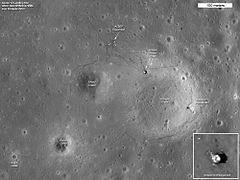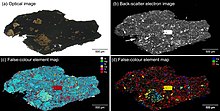
An impact crater is a circular depression in the surface of a solid astronomical object formed by the hypervelocity impact of a smaller object. In contrast to volcanic craters, which result from explosion or internal collapse, impact craters typically have raised rims and floors that are lower in elevation than the surrounding terrain. Lunar impact craters range from microscopic craters on lunar rocks returned by the Apollo program and small, simple, bowl-shaped depressions in the lunar regolith to large, complex, multi-ringed impact basins. Meteor Crater is a well-known example of a small impact crater on Earth.

A meteorite is a solid piece of debris from an object, such as a comet, asteroid, or meteoroid, that originates in outer space and survives its passage through the atmosphere to reach the surface of a planet or moon. When the original object enters the atmosphere, various factors such as friction, pressure, and chemical interactions with the atmospheric gases cause it to heat up and radiate energy. It then becomes a meteor and forms a fireball, also known as a shooting star; astronomers call the brightest examples "bolides". Once it settles on the larger body's surface, the meteor becomes a meteorite. Meteorites vary greatly in size. For geologists, a bolide is a meteorite large enough to create an impact crater.

Phobos is the innermost and larger of the two natural satellites of Mars, the other being Deimos. The two moons were discovered in 1877 by American astronomer Asaph Hall. It is named after Phobos, the Greek god of fear and panic, who is the son of Ares (Mars) and twin brother of Deimos.
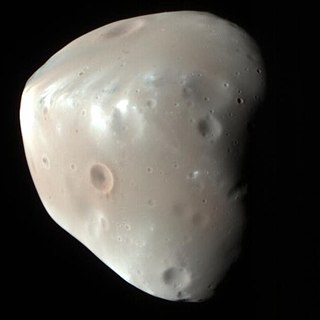
Deimos is the smaller and outermost of the two natural satellites of Mars, the other being Phobos. Deimos has a mean radius of 6.2 km (3.9 mi) and takes 30.3 hours to orbit Mars. Deimos is 23,460 km (14,580 mi) from Mars, much farther than Mars' other moon, Phobos. It is named after Deimos, the Ancient Greek god and personification of dread and terror.

A lander is a spacecraft that descends towards, then comes to rest on the surface of an astronomical body other than Earth. In contrast to an impact probe, which makes a hard landing that damages or destroys the probe upon reaching the surface, a lander makes a soft landing after which the probe remains functional.
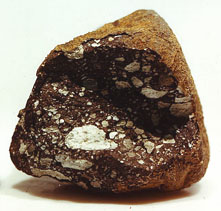
A lunar meteorite is a meteorite that is known to have originated on the Moon. A meteorite hitting the Moon is normally classified as a transient lunar phenomenon.

In planetary geology, a ray system comprises radial streaks of fine ejecta thrown out during the formation of an impact crater, looking somewhat like many thin spokes coming from the hub of a wheel. The rays may extend for lengths up to several times the diameter of their originating crater, and are often accompanied by small secondary craters formed by larger chunks of ejecta. Ray systems have been identified on the Moon, Earth, Mercury, and some moons of the outer planets. Originally it was thought that they existed only on planets or moons lacking an atmosphere, but more recently they have been identified on Mars in infrared images taken from orbit by 2001 Mars Odyssey's thermal imager.

The Genesis Rock is a sample of Moon rock retrieved by Apollo 15 astronauts James Irwin and David Scott in 1971 during the second lunar EVA, at Spur crater. With a mass of c. 270 grams, it is currently stored at the Lunar Sample Laboratory Facility in Houston, Texas.
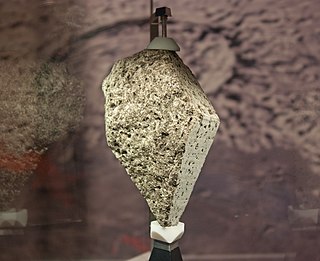
Moon rock or lunar rock is rock originating from Earth's Moon. This includes lunar material collected during the course of human exploration of the Moon, and rock that has been ejected naturally from the Moon's surface and landed on Earth as meteorites.

An ejecta blanket is a generally symmetrical apron of ejecta that surrounds an impact crater; it is layered thickly at the crater's rim and thin to discontinuous at the blanket's outer edge. The impact cratering is one of the basic surface formation mechanisms of the solar system bodies and the formation and emplacement of ejecta blankets are the fundamental characteristics associated with impact cratering event. The ejecta materials are considered as the transported materials beyond the transient cavity formed during impact cratering regardless of the state of the target materials.

Crater counting is a method for estimating the age of a planet's surface based upon the assumptions that when a piece of planetary surface is new, then it has no impact craters; impact craters accumulate after that at a rate that is assumed known. Consequently, counting how many craters of various sizes there are in a given area allows determining how long they have accumulated and, consequently, how long ago the surface has formed. The method has been calibrated using the ages obtained by radiometric dating of samples returned from the Moon by the Luna and Apollo missions. It has been used to estimate the age of areas on Mars and other planets that were covered by lava flows, on the Moon of areas covered by giant mares, and how long ago areas on the icy moons of Jupiter and Saturn flooded with new ice.

The Hadley Rille meteorite was a meteorite discovered on the Moon at coordinates 26° 26' 0" N, 3° 39' 20" E, or Station 9A, during the Apollo 15 mission in 1971. It was the second meteorite to be discovered on a Solar System body other than the Earth. The first was the Bench Crater meteorite, discovered in 1969 during the Apollo 12 mission.

Extraterrestrial material refers to natural objects now on Earth that originated in outer space. Such materials include cosmic dust and meteorites, as well as samples brought to Earth by sample return missions from the Moon, asteroids and comets, as well as solar wind particles.

Complex craters are a type of large impact crater morphology.

The Late Heavy Bombardment (LHB), or lunar cataclysm, is a hypothesized astronomical event thought to have occurred approximately 4.1 to 3.8 billion years (Ga) ago, at a time corresponding to the Neohadean and Eoarchean eras on Earth. According to the hypothesis, during this interval, a disproportionately large number of asteroids and comets collided into the terrestrial planets and their natural satellites of the inner Solar System, including Mercury, Venus, Earth and Mars. These came from both post-accretion and planetary instability-driven populations of impactors. Although it used to be widely accepted, it remained difficult to provide an overwhelming amount of evidence for the hypothesis. However, recent re-appraisal of the cosmo-chemical constraints indicates that there was likely no late spike in the bombardment rate.

Nakhlites are a group of Martian meteorites, named after the first one, Nakhla meteorite.

The geological history of Mars follows the physical evolution of Mars as substantiated by observations, indirect and direct measurements, and various inference techniques. Methods dating back to 17th-century techniques developed by Nicholas Steno, including the so-called law of superposition and stratigraphy, used to estimate the geological histories of Earth and the Moon, are being actively applied to the data available from several Martian observational and measurement resources. These include landers, orbiting platforms, Earth-based observations, and Martian meteorites.

Planetary science is the scientific study of planets, celestial bodies and planetary systems and the processes of their formation. It studies objects ranging in size from micrometeoroids to gas giants, aiming to determine their composition, dynamics, formation, interrelations and history. It is a strongly interdisciplinary field, which originally grew from astronomy and Earth science, and now incorporates many disciplines, including planetary geology, cosmochemistry, atmospheric science, physics, oceanography, hydrology, theoretical planetary science, glaciology, and exoplanetology. Allied disciplines include space physics, when concerned with the effects of the Sun on the bodies of the Solar System, and astrobiology.
Catherine Margaret Corrigan, often known as Cari Corrigan, is an American scientist best known as a curator of the meteorite collection at the Smithsonian Institution. She is a scientist in the Department of Mineral Science at the National Museum of Natural History.

Lunar Sample 14321, better known as "Big Bertha", is a lunar sample containing an embedded Earth-origin meteorite collected on the 1971 Apollo 14 mission. It was found in the Fra Mauro region of the Moon. Big Bertha is the first discovered meteorite from Earth, and the embedded meteorite portion is the oldest known Earth rock. At 8.998 kg (19.84 lb), this breccia rock is the third largest Moon sample returned during the Apollo program, behind Big Muley and Great Scott.

